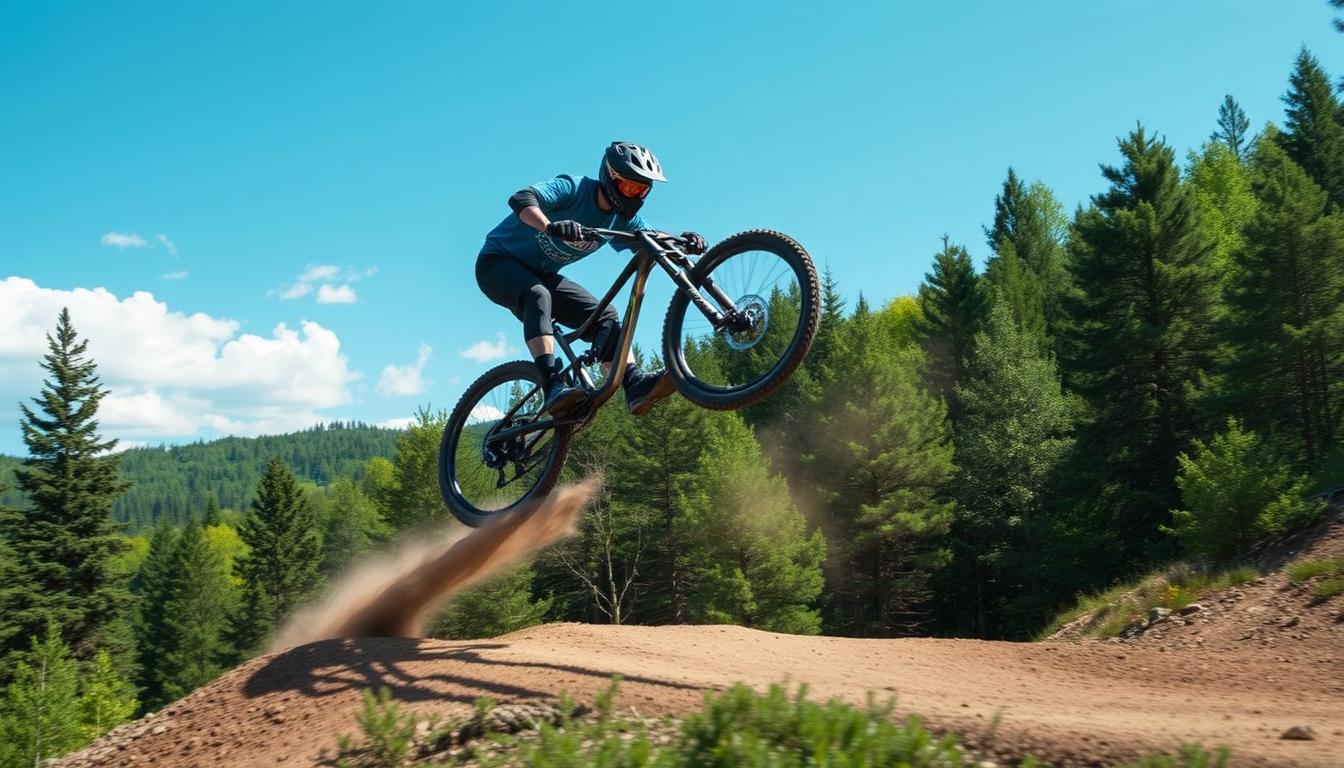Mastering the whip is key for any serious mountain biker. It gives you more control and style on the trails. To learn, you first need to know the basics of mountain bike whipping techniques.
With good air awareness and confidence in jumps, you’re ready to start learning whips. This is a crucial skill to master.
Learning to whip your mtb like a pro takes patience, practice, and dedication. To perform a whip, settle on the bike evenly and look towards the lip. The trick is to slowly increase the angle of the whip, bit by bit.
Don’t try to whip at a huge 90-degree angle right away. Start small and build up your skill.
Key Takeaways
- Mastering the whip is an essential skill for any serious mountain biker
- Good air awareness and confidence in jumps are required to learn how to do whips
- Mountain bike whipping techniques involve gradually increasing the angle of the whip
- Practicing the skill on a familiar and comfortable jump is crucial to avoid mishaps
- Introducing sideways movement through the handlebars and hips can improve whipping technique
- Simon Lawton, a renowned mountain biking instructor, emphasizes the importance of taking time to practice whips
Understanding the MTB Whip: What Makes it Special
The MTB whip is a key technique in mountain biking. It involves rotating the bike in mid-air for a smooth landing. To get better at whipping, knowing its history and importance is crucial. The whip’s roots come from motocross and BMX racing.
Eric Carter introduced mountaincross in 1999 at the Glen Helen Outdoor MX National. This event helped the MTB whip grow. The Sideflight Champs in 2009 was a contest for the best whip. Riders like Thomas Vanderham showed off their skills.
To master the MTB whip, focus on these tips: proper technique, practice, and patience.
- Aiming for the far corner of a take-off
- Loading up the rear suspension
- Throwing the front wheel down at the right moment
By following these tips and practicing, you can enhance your whipping skills. The MTB whip is a unique and thrilling technique. It demands skill, practice, and dedication.
Riders like Tyler McCaul, Bernardo Cruz, and Finn Iles are known for their whip skills. You can also become recognized by focusing on technique and practice. Always wear safety gear and ride within your limits.
Essential Equipment for Safe Whipping
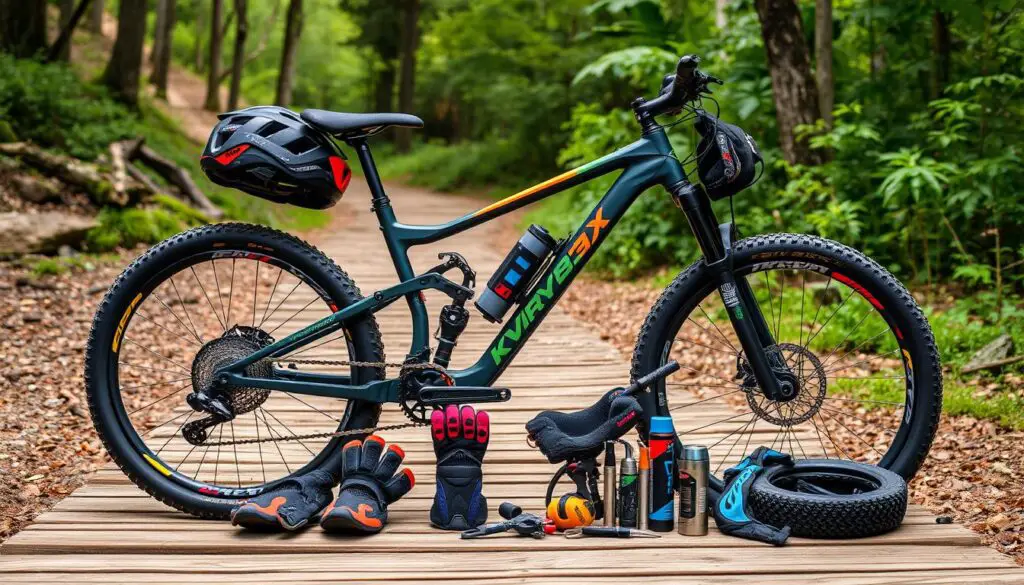
For a beginner’s guide to whipping on a mountain bike, the right gear is key. You’ll need a sturdy bike, a good suspension system, and safety items like a helmet and knee pads. Gloves and shoes with grip help control the bike better.
Some important items to think about include:
- A mountain bike with a lightweight and durable frame, such as aluminum or carbon fiber
- A reliable suspension system that can handle tough terrains
- Proper safety gear, including a helmet, knee pads, and elbow pads
- Gloves and shoes that provide extra grip and control
It’s also vital to check your bike often for any damage. This keeps it safe and running well. With the right gear and care, you can avoid injuries and get better at whipping.
With the right tools and practice, you can whip like a pro. This will boost your mountain biking skills, following a beginner’s guide to whipping on a mountain bike.
Preparing Your Bike for Whip Training
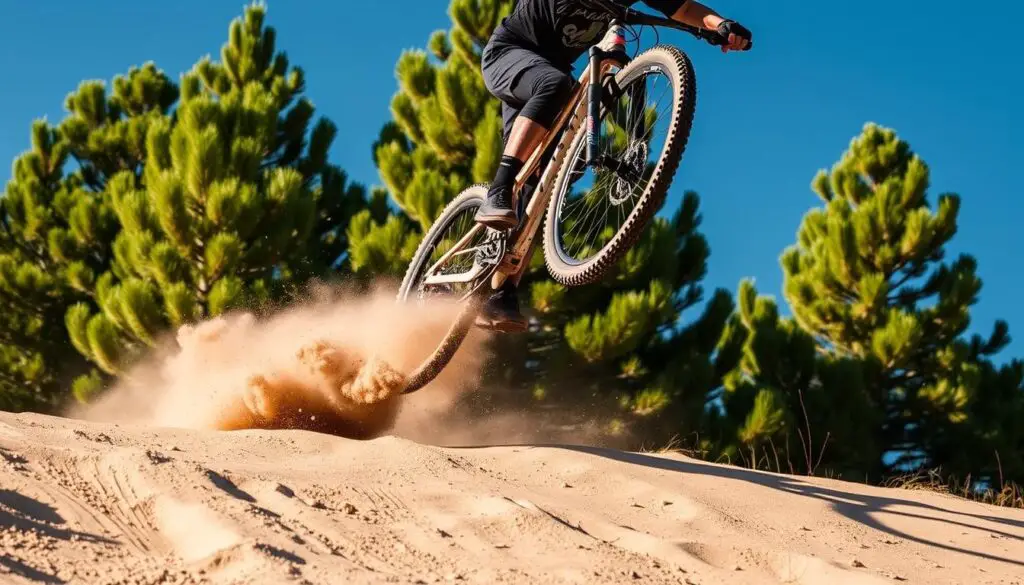
To master mountain bike whipping techniques, you need to get your bike ready. This means setting up your suspension to handle shocks and bumps. Also, check your tire pressure for the right grip and control. Make sure all parts are working well.
Regular maintenance is key to avoid mechanical failures and injuries. A well-maintained bike is essential for improve your mtb whipping skills. Here are some important checks to make:
Suspension Setup
Adjust your suspension to fit your riding style and terrain. This keeps you in control and stable while doing whip maneuvers.
Tire Pressure Recommendations
Check your tire pressure often to keep it at the right level. The right pressure gives you the grip and control needed for whip maneuvers.
Crucial Component Checks
Regularly check your bike’s parts, like brakes, gears, and chain. This ensures they work well and prevents mechanical failures and injuries.
By following these tips and keeping your bike in good shape, you’ll get better at improve your mtb whipping skills and mountain bike whipping techniques. Always wear safety gear, like a helmet, knee pads, and gloves, when practicing whip maneuvers.
| Bike Model | Price |
|---|---|
| XJD Children’s Height-Adjustable Balance Bike | $72 USD |
| XJD Boys Bike Blue | $169 USD |
| XJD Boys Bike Black | $169 USD |
| XJD Boys & Girls Bike White | $169 USD |
Basic Body Position and Stance for MTB Whips
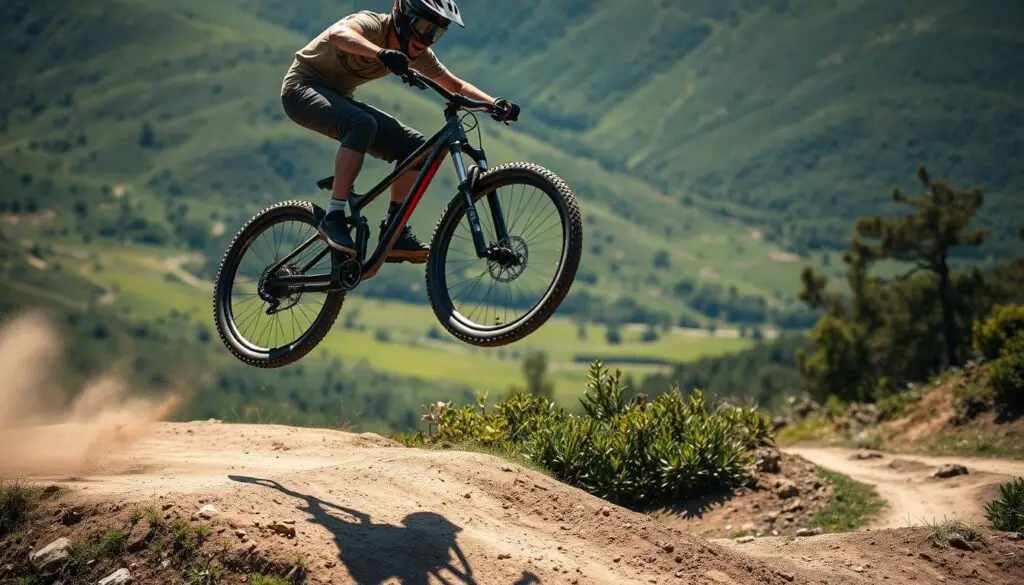
Learning how to whip mtb starts with the right body position and stance. Keep your weight balanced over the bike. Bend your knees and keep your arms relaxed. Look ahead and position your body to handle bumps.
Simon Lawton, an expert with over 20 years of teaching, says mastering this is key. He has won over 50 times at regional events. Lawton stresses proper technique in his videos and films on iTunes.
Here are some important tips for body position and stance:
- Keep your weight centered over the bike
- Bend your knees to absorb shocks and bumps
- Relax your arms to maintain control
- Focus your eyes on the horizon to stay balanced
By following these tips and practicing, you’ll get better at the whip. This will help you improve your mountain biking skills.
How to Whip MTB: Step-by-Step Technique
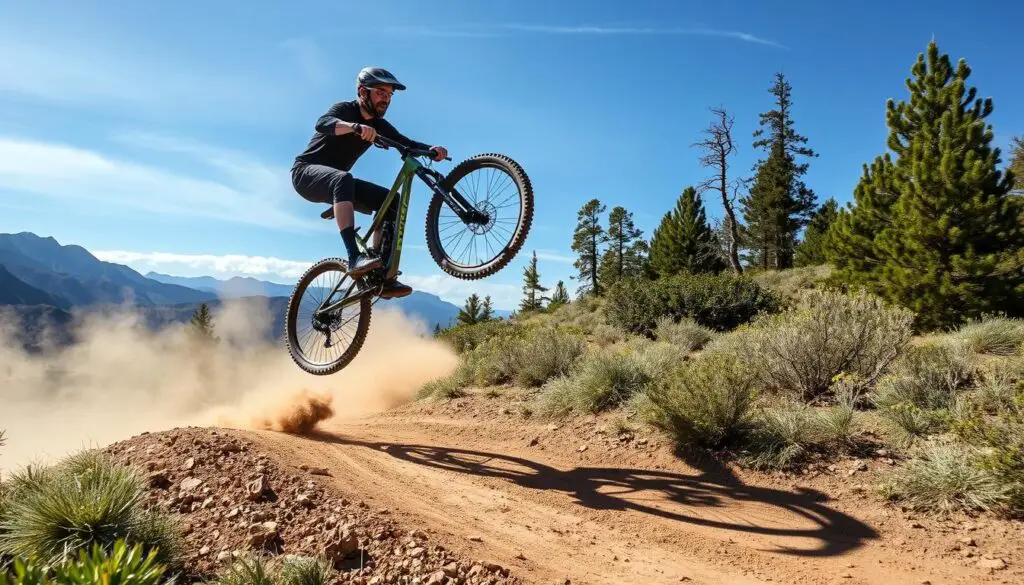
Learning mountain bike whipping techniques takes skills and practice. It’s key to break it down into steps for beginners. Experts have developed methods like The Fluidride Method to help riders improve.
First, riders set up their speed and path. This is crucial for the height and distance of the whip. Then, they launch the bike into the air, needing precise timing and control. Mid-air control is essential for balance and adjusting the bike’s position for a safe landing.
To get better, riders should follow a beginner’s guide. It includes practicing the initial approach and take-off on smaller jumps. They also need to work on mid-air control and landing safely.
- Practicing the initial approach and take-off phase on smaller jumps
- Developing mid-air control through exercises and drills
- Focusing on landing safely and smoothly
Initial Approach
Riders should pick a suitable jump and approach it at the right speed. They need to assess the jump’s size and shape, and their own skill and comfort level.
Take-off Phase
The take-off phase needs precise timing and control. Riders shift their weight and use the bike’s suspension to absorb the impact.
Mid-air Control
In the air, riders adjust their body position and the bike’s path to control and balance. They make small adjustments to the bike’s angle and speed.
Landing Safely
Lastly, riders focus on landing safely and smoothly. They use the bike’s suspension and their body position to absorb the impact. This involves rolling with the landing and keeping control of the bike.
| Step | Description |
|---|---|
| 1. Initial Approach | Set up speed and trajectory |
| 2. Take-off Phase | Launch the bike into the air |
| 3. Mid-air Control | Maintain balance and adjust trajectory |
| 4. Landing Safely | Absorb impact and maintain control |
Finding the Perfect Jump for Practice
To get better at mtb whipping, find a jump that fits your style and skill. Jumps differ in size, height, and shape. Bike parks have easier jumps, but technique is key, not just speed.
When looking for the right jump, think about these things:
- Size: Start with small jumps and move to bigger ones as you get more confident and skilled.
- Shape: Tabletops are great for practice because they help you avoid coming up short.
- Trajectory: Choose jumps with a smooth path to keep your speed and control.
Practice with the right technique, like timing and preload. Commitment and confidence come from doing well over and over. Lean your weight and spot the landing to stay on track. With time and effort, you’ll get better at jumping.
Follow these tips to get good at mtb whipping. Always start small, stay calm, and focus on technique. With hard work and practice, you’ll be ready for tough jumps and improve your riding.
Common Mistakes and How to Avoid Them
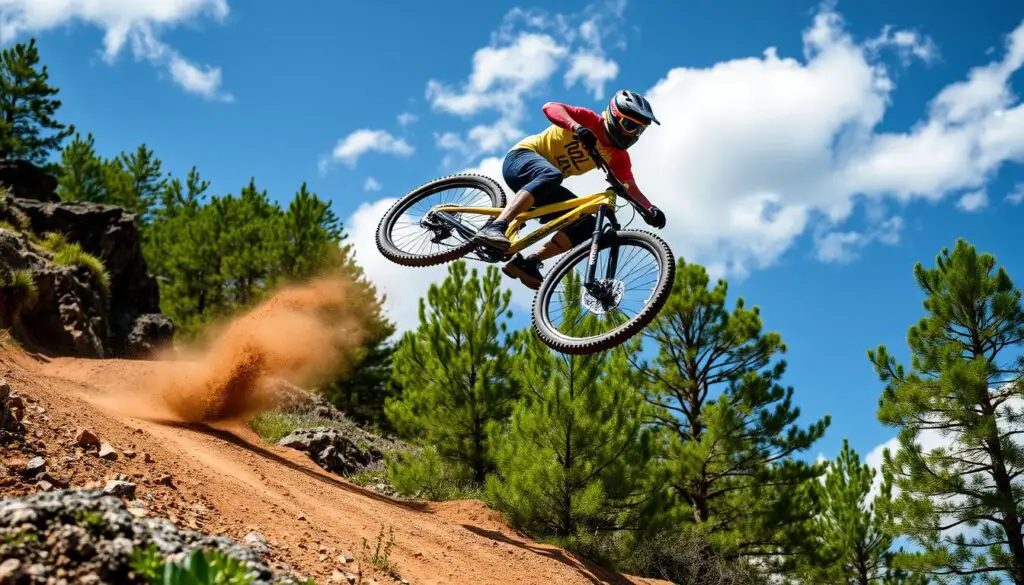
Learning how to whip mtb can be tricky. It’s important to know common mistakes that can slow you down or even hurt you. Getting good at mountain bike whipping techniques takes time, patience, and paying close attention to details.
Here are some key areas where mistakes often happen:
- Timing issues: Getting the timing wrong can mess up your whole trick, making it hard to do it right.
- Body position errors: Keeping the right body position and stance is key for balance and control.
- Landing problems: Landing safely is crucial to avoid injuries and keep moving.
By working on these areas and practicing a lot, you can get better at how to whip mtb and master mountain bike whipping techniques. Start with small jumps, work on your upper body strength, and keep the right posture to jump higher.
Also, get to know the trail, pick the right trails, and make sure your bike is in good shape to avoid accidents. With hard work and practice, you’ll be able to do a successful whip and improve your mountain bike whipping techniques.
| Mistake | Correction |
|---|---|
| Incorrect timing | Practice timing drills to improve coordination |
| Body position errors | Maintain correct posture and stance |
| Landing problems | Focus on safe landing techniques and practice regularly |
Progressing Your Whip Game
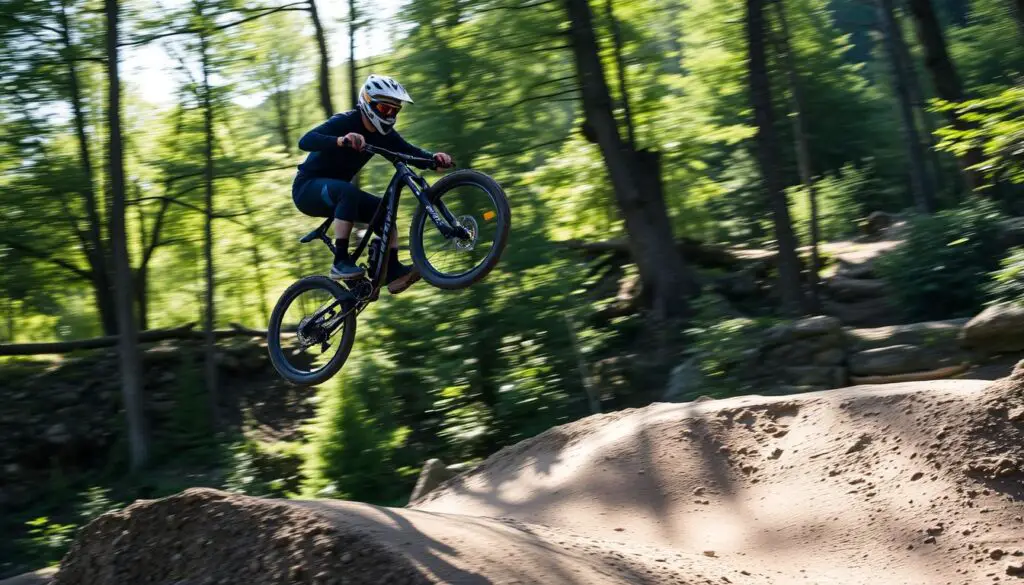
To get better at mtb whipping, you need a solid plan. A good guide should include a step-by-step plan, goals, and practice with a friend. This keeps you motivated and helps you grow.
Having a positive mindset is key when facing challenges. Celebrate small wins and focus on improving with each try. Regular practice and getting tips from experts can also boost your skills.
Here are some tips to improve your whip game:
- Practice regularly, aiming for 2-3 times a week
- Start with small jumps and gradually increase the size and difficulty
- Experiment with different techniques and styles
- Seek feedback from experienced riders or instructors
Mastering the whip takes time, patience, and hard work. By sticking to a plan and staying committed, you can enhance your mtb whipping skills. As a beginner, it’s vital to follow a guide to learn the right techniques and stay safe.
With determination, resilience, and a positive attitude, you can beat obstacles and reach your goals. So, keep practicing, and soon you’ll be whipping like a pro.
| Practice Frequency | Jump Size | Technique |
|---|---|---|
| 2-3 times a week | Small to medium | Basic whip |
| 3-4 times a week | Medium to large | Advanced whip |
Advanced Whipping Techniques
As riders get better at mountain bike whipping, they can try new styles and tricks. They can play with their body position and the bike’s angle in mid-air. This helps them create a unique style that makes them stand out.
Advanced tricks include adding twists or flips to the whip. It takes a lot of skill and understanding of the bike and rider. By practicing, riders can get better and feel more confident on their bike.
Style Variations
Riders can try different styles like the “lazy whip” or “inverted whip.” These need speed, balance, and control. They make the ride more exciting and challenging. Mastering these styles lets riders show off their skills in competitions or group rides.
Combining Tricks
Linking tricks together is an advanced move. It involves doing a whip and then another trick, like a jump or drop. It needs a lot of skill, timing, and coordination. Practicing these combinations makes the ride smoother and more dynamic.
For example, a rider might do a whip and then a tabletop jump. Or they might do a series of whips in a row. Trying different combinations lets riders explore new limits and create a unique style.
Safety Considerations and Protective Gear
When learning how to whip mtb, safety is key. A beginner’s guide to whipping on a mountain bike will tell you to wear the right gear. This includes a helmet, knee pads, and more to protect you from falls.
It’s also important to know your surroundings and watch out for dangers. Check the terrain before you start, avoid obstacles, and be careful of others. This way, you can stay safe and have fun.
Wearing the right gear and being careful are crucial. Always wear a helmet that meets safety standards. Look for certifications from the Consumer Product Safety Commission (CPSC) or the Snell Memorial Foundation.
Consider knee pads, elbow pads, and more for extra protection. Brands like Ninja, Fox, POC, and Evoc offer great options. Their products, like Ninja’s Speed King and Hooligan pads, provide both safety and comfort. With the right gear and safety habits, you can enjoy whipping mtb safely.
Training Exercises to Improve Your Whip
To get better at mtb whipping, you need to practice regularly. There are three main areas to focus on: off-bike prep, on-bike drills, and mental training. These help build the skills and confidence you need to master the whip.
Off-bike prep includes stretching and strengthening to boost flexibility and fitness. On-bike drills are about practicing jumps and tricks to learn the whip’s techniques. Mental training, like visualization and focus, is also key for better whipping skills.
Off-bike Preparation
Off-bike prep is vital for whipping skills. It includes:
- Stretching to improve flexibility
- Strengthening exercises to build muscle
- Cardiovascular training to improve endurance
Adding these to your routine boosts your fitness and lowers injury risk.
On-bike Drills
On-bike drills help you learn the whip’s skills and techniques. They include:
- Practicing jumps and tricks
- Mastering carving and turning
- Learning to shift body weight and adjust bike position
Regular practice of these drills enhances your whipping skills and boosts confidence.
Mastering the mtb whip requires time and effort. By following these tips and practicing, you can enhance your skills and become more confident and skilled.
| Training Exercise | Benefits |
|---|---|
| Off-bike preparation | Improves flexibility and overall physical fitness |
| On-bike drills | Develops skills and techniques needed to execute a successful whip |
| Mental training | Improves focus and confidence |
Conclusion: Mastering Your MTB Whip
Learning to whip your MTB takes time, patience, and practice. As you get better at how to whip mtb, focus on the right techniques and safety. With the right tools and training, you can explore new trails and improve your mountain bike whipping techniques.
It’s crucial to know about safety and wear the right gear. This helps you avoid injuries and feel more confident on your bike. Keep practicing and always be ready for new challenges.
MTB whipping is exciting for all riders, whether you’re new or experienced. It combines speed, style, and skill, making it a fun challenge. So, grab your bike and start whipping. With the right skills and attitude, you’ll be riding like a pro in no time.

I am Ryan Ford, a mountain biking enthusiast who loves to explore the outdoors. I also like to go on adventures with friends and anything else that involves being outside. I love my bike because it gets me out of the house and gives me an opportunity to enjoy nature.

